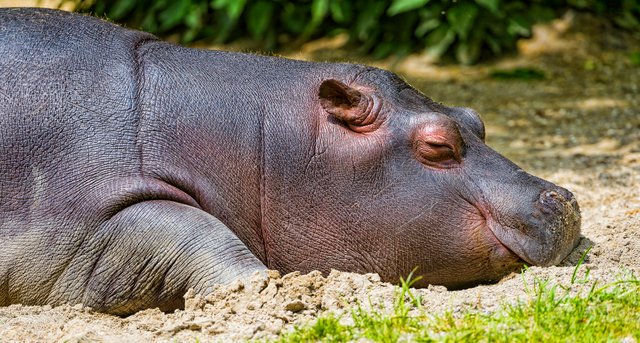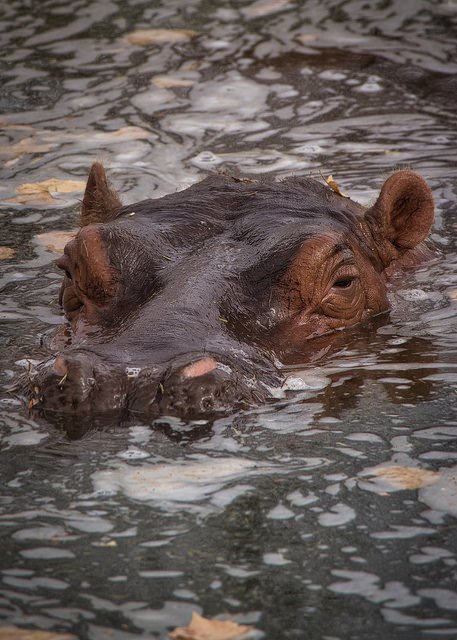Animal Series #15; Hungry Hungry Hippos

They might look like a pig, but they were not. A hippopotamus, also known as a hippo, is one of the three largest animals on the land beside an elephant and a rhinoceros. They might look fat, chubby and overweight but they were able to sprint off as fast as 30 km/h over a few hundred metres. A hippo (I will be using that instead of hippopotamus), was one of the descendants of Whippomorpha. It comprises of two diverse groups which are Hippopotamidae and Cetacea, a group of aquatic animals which are usually carnivorous such as a whale and a dolphin. Hippos can be found mostly sinking in the river somewhere in Savannah, cooling their skin while protecting it from the harmful radiation which can potentially be caused by the sun.
They might seem weak, docile, fat and easily fatigue but they were considered as one of the most dangerous animals in the world. I did say that Cetaceans were usually carnivorous but a large portion of the hippo's diets were grasses. Recently, about a decade or so, there has been some documentation regarding hippos commit a cannibalistic act by consuming their own species carcasses. They spent most of their time in the river or lake, and it was determined that this animal is not at all territorial on the land. They do live together in a group at a single huge location but each individual hippos love to spend some time in solitary, doing anything by themselves, floating around aimlessly while watching the sun goes down.
The largest hippo ever recorded weighed around 3,200 kg and it was unclear whether that was a male or female hippo. How is it different from each other? Well, a female hippo will grow up to 25 years old, which means their weight and size will stay pretty much consistent throughout life (from when she was 25 years old). A male hippo, however, will grow bigger and heavier throughout life and their average lifespan was recorded between 40 to 50 years old. They were semiaquatic, which means, they spent some time in the water while the other loafing around on land (usually at night). They have a pretty thick skin which makes them one of the most difficult prey to be dealt with by any predators.

There have been a few articles which described red-coloured discharged fluid which is secreted through the hippo's skin. Some people thought it to be blood but actually, it is a substance which confers natural protection against harmful solar radiation. It composed of two type of pigments which are:
- Hipposudoric acid
- Norhipposudoric acid
Both of these pigmented compounds were highly acidic, providing some protection against harmful microbial agents. They were also made to be able to absorb light within the ultraviolet wavelength which makes them an effective natural sunscreen. Having a barrel-shaped body is not that bad considering they were able to support their own massive and heavy structure. The ability for an animal to support their own great weight was termed as graviportal. Unlike any other heavyweight animals, hippo has a set of small legs which if we were to think rationally, seems weak to support such a heavy structure. Despite that, just like what I have mentioned earlier, they can run as fast as 30 km/h in a short distance. It's pretty impressive, isn't it?
Cannibalism among hippos

The majority of plants ate by a hippo are grasses. They can eat up to 40 kg of grasses to maintain their own figures which can be attained by minimal physical activity (floating around) and eat more than what it normally required on a daily basis. Unlike any other animals, hippos have bacterial-free intestine when they were born. It is important for a baby hippo to obtained some gut bacteria from its mother's faeces to digest fibres; the majority of nutrients that can be extracted from plants. Even though they seem like a vegetarian super-sized beast, there have been some records regarding cannibalistic and carnivorous behaviour among hippos in the past few decades.
In 2015, Leejiah J. Dorward, a scholar from the Imperial College London witnessed a hippo was eating another dead hippo while being surrounded by crocodiles in the Kruger National Park, South Africa. Even though it is pretty rare to see this kind of behaviour in hippos, this is not the first cannibalistic behaviour that has been recorded in the literature. The first record of carnivorous behaviour was observed by Dudley in 1995 when he saw an antelope being killed and eaten by 10 hippos while the antelope was trying to escape from some wild dogs. As their prey has been snatched away by hippos, the wild dogs killed another one nearby to feed themselves but as soon as the second antelope was dead, all of the hippos from the first antelope's carcass chased away the wild dogs and snatched the second carcass. It's like they were trying to compete with the other predators to feed themselves.

Anatomically speaking, a hippo's intestine is not suited for processing meat. The only thing which can explain why they committed cannibalistic behaviour is due to the lack of food sources. Even though there is only 2 documented literature up to 2015, the number of observed carnivorous behaviour among hippos might have exceeded that. In 1989, Crowther and Whyte claim to observe a female kudu's carcass being eaten by a hippo. That particular kudu has been killed by crocodiles and the remaining carcass was scavenged by the nearby hippos. However, it is uncertain whether or not the feeding session took place.
The first ever observed cannibalistic behaviour among hippos took place in 1999 in the Shire River, Malawi. It's practically difficult to kill a hippo under normal circumstances but if the hippo was badly injured because of some fight among them, they can be easily dominated by the other apex predators. The hippo was practically dead a day before and it was eaten by the other member of its group. That doesn't sound fancy at all. The occurrence of cannibalism seems to be increased during the drought where food sources were scarce. If that was, in fact, true, then they will pretty much eat anything to survive the drought including their own flesh and blood. Desperate time, desperate measure.
Hippo's poop; Toxic to the fishes
I did say the fact that hippos can eat up to 40 kg of grass per day, have I? So with that kind of information, how much poops they will be able to produce on a daily basis? Well, there is no specific figures that estimate the amount of dung produced by a single hippo but in a group, they produce approximately 8 tonnes of poop per day. Even though we knew most of the natural things, even excrement can provide a beneficial effect in a specific ecosystem, hippo's poop seems to pose a great liability to the fishes which have been living downstream from the site of a group of hippos gathered.

Hippos spend most of their night, wandering around the Savannah, and when the sunrise, they immerse themselves in the river to cool off their skin. If you're thinking, that's the only thing they were doing, then you're wrong. While indulging themselves in the cold water, they began to excrete waste product of digestion into the river. This causes the level of oxygen in the water becomes depleted. Decomposition of the waste product causes a great amount of oxygen being used by the microbial agents related to that particular processes.
The decomposition process will not only deplete the level of oxygen but also raise the concentration of some of the compounds which are detrimental to the fishes such as ammonia and hydrogen sulphide. Now, when the river flows downstream, a number of fishes species would be affected by the low-oxygen and high ammonia/hydrogen sulphide water which will make fishes, to use the term, "suffocate". This progressive and sudden hypoxia can potentially affect a thousand if not millions of fishes which later will kill a significant number of them.

Currently, hippos have been listed as "vulnerable" in the IUCN red list. They were threatened by poaching and habitat destruction which is further exacerbated by the fact that they were eating each other to survive harsh environments.
References and further reading materials
- Hippopotamus - Wikipedia. Retrieved on May 26th, 2018
- Animal cannibalism - who does it and why. Retrieved on May 26th, 2018
- New record of cannibalism in the common hippo, Hippopotamus amphibius (Linnaeus, 1758). Retrieved on May 26th, 2018
- The truth about hippos: herbivore or cannibal?. Retrieved on May 26th, 2018
- Hippo waste causes fish kills in Africa's Mara River. Retrieved on May 26th, 2018
- Hippo Poop Is Literally Suffocating Fish. Retrieved on May 26th, 2018

SteemSTEM is a community project with the goal to promote and support Science, Technology, Engineering and Mathematics on the Steem blockchain. If you wish to support the steemSTEM project you can:
Contribute STEM content using the #steemstem tag | Support steemstem authors | Join our curation trail | Visit our Discord community | Delegate SP to steemstem



All this facts about hippo
Something I would not think of due to try fact that they are really big
Explains where the fatness comes from
Nice one about hippopotamus.....
Are they part of the pig family?sorry for the almost silly question... Too many outward SimilaritiesNope. They were never related to the pig family. Most of the data and genetic evidence have pointed out hippos of being closely related to whales, not to a pig. Sure, whales are closely related to Indohyus or India's pig which has extinct making it plausible to assume their relatedness to hippos as well but both of hippos and whales were never closely related to the living pigs.
Thanks for that
Well, for me hippos have always look very strong and big haha
That is a lot! No wonder why sometimes they must turn cannibal and eat one of their own, with each hippo eating so much they can deplete any food resource there might be.
Cheers @chloroform!
Thank you for your feedback @dedicatedguy.
Congratulations @chloroform! You have completed some achievement on Steemit and have been rewarded with new badge(s) :
Click on any badge to view your Board of Honor.
To support your work, I also upvoted your post!
For more information about SteemitBoard, click here
If you no longer want to receive notifications, reply to this comment with the word
STOPDo not miss the last announcement from @steemitboard!
This is one of my favorite bits of hippo trivia and is documented all the back to ancient Rome and Egypt.
Yes, it is. Thanks for your feedback @effofex.
Holly hippos! :D
A 3 ton hippo, bigger than an elephant. lol.
I'm not sure about the size in comparison with the elephant but some of them were heavier than elephants.
Hippos are the only creatures in Africa that can easily kill a crocodile, and even lions and other predators treat them with respect.
Yes, they were treated with respect. In some occasions, even a crocodile wouldn't dare to disturb a hippo eating their own flesh and blood. They just observe and wait if there is any leftover for them.
Poor animals, I can imagine what they would have gone through due to starvation and now have to feed on their own kind for survival. But these animals really poo a lot with that huge body of they possess.
Of course. They ate an average of 40 kg of grass for god sake.
That is true.